Protect yourself from ticks! Since last fall, the Crimean-Congo hemorrhagic fever virus has been spotted in so-called giant ticks, of the species Hyalomma marginatum. “No human cases have been diagnosed in France to date, warned Public Health France last May. However, the risk of contamination has now been demonstrated, because Hyalomma ticks infected with the virus are present in the south of France..” These insects have been installed in Corsica for many years and for around ten years on the entire French Mediterranean coast.
Crimean-Congo hemorrhagic fever: flu-like symptoms in less serious cases
In the event of a bite from a tick of this species, there is therefore a risk of contamination by Crimean-Congo hemorrhagic fever. “Infection with this virus is, in most cases, not very symptomatic, but it can also cause illness with severe or even fatal forms., specifies the Pasteur Institute. The first symptoms appear between five and seven days after contamination and are similar to those of the flu: muscle pain, dizziness, fever, stiff neck, headache, sensitivity to light. “There may be nausea, vomiting, diarrhea, abdominal pain and sore throat at first, followed by sudden mood swings and confusion., notes the World Health Organization. After a few days, some people may also experience depressive symptoms or a form of weariness.
A risk of hemorrhage and death in severe forms of Crimean-Congo hemorrhagic fever
In the most serious cases, the disease causes hemorrhages and a rapid deterioration in the functioning of the kidneys and liver, even the lungs. According to the World Health Organization, when it takes this form, the pathology is fatal in 10 to 40% of cases. “For those who recover, general condition begins to improve nine to ten days after the onset of symptoms.”estimates the Pasteur Institute.
How to treat Crimean-Congo hemorrhagic fever?
In the event of contamination, treatment consists of managing the symptoms. “An antiviral drug, Ribavirin, has been proposed to treat patients when symptoms appear but its effectiveness is still debated.he says.
The organization reminds that there is no vaccination to protect yourself. To reduce the risk of contamination, bite prevention is the best solution.
If you go out into the forest or into potentially infested areas, you must:
- wear long, light-colored clothing;
- use repellents on skin and clothing;
- regularly check that no ticks are present on the skin.
When the insect is on the skin, it is important to remove it gently, ideally with suitable tweezers, called a tick remover, and to properly disinfect the area afterwards.






